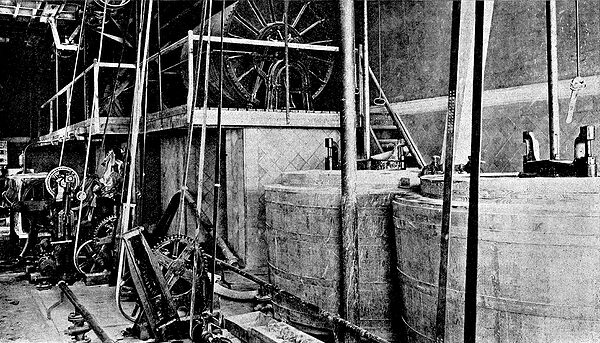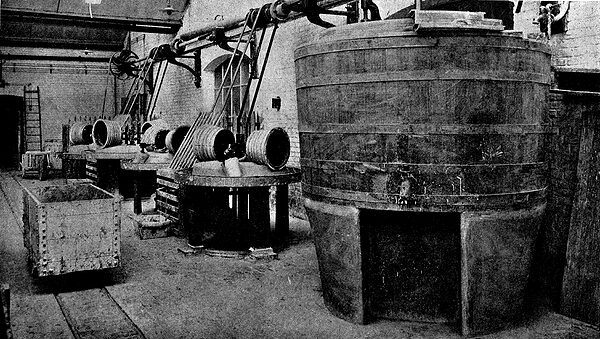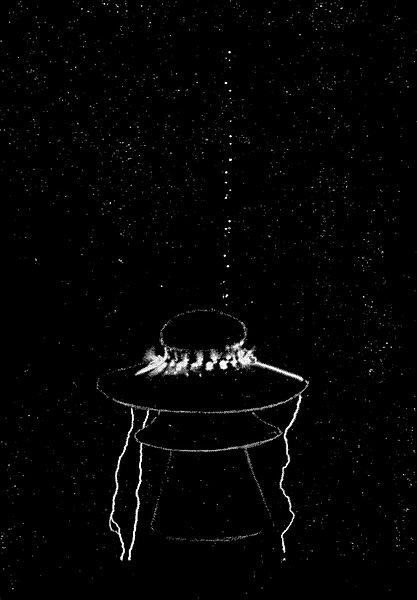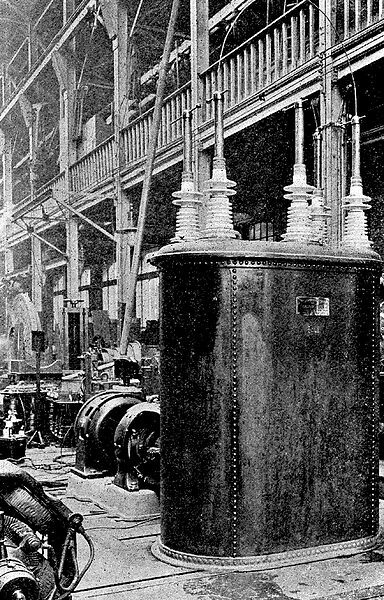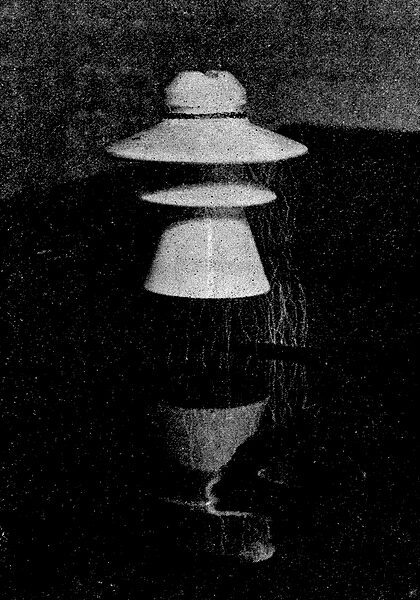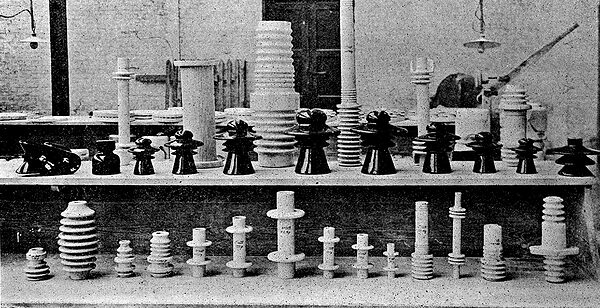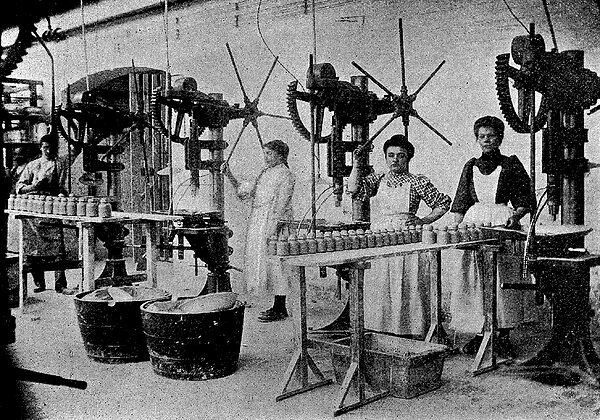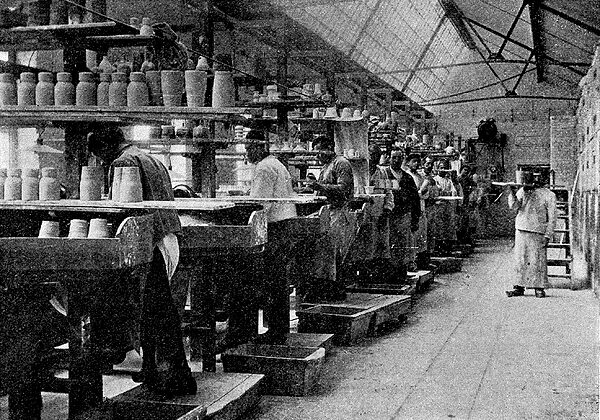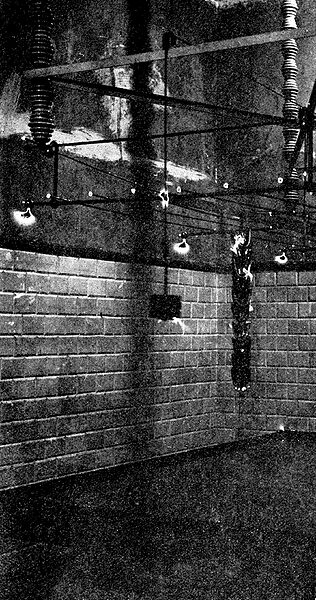[Trade Journal]
Publication: Scientific American Supplement
New York, NY, United States
vol. 74, no. 1909, p. 72-73, col. 1-3
| |||
| The Hall in Which the Porcelain Articles Are Shaped. |
The Manufacture of Porcelain Insulators
Testing the Products for Leakage at High Tension
By Dr. Alfred Gradenwitz
| |||
| The Pugmills and Filter Presses. |
| |||
| Mechanical Kneaders Working the Crude Mass. |
PORCELAIN consists mainly of a mixture of kaolin, quartz, and felspar, in proportions variable to a high extent in accordance with the purpose it is intended for. For electrical applications hard porcelain, consisting of a kaolin core immersed in felspar and quartz paste, is used exclusively. This composition, which is burnt at a very high temperature, gives a very high mechanical and electrical resistance, as required in electrical insulators.
| |||
| Appearance Presented by An Insulator During A High-Tension Test. |
After being crushed and ground, the quartz and felspar are thrown into troughs filled with water and fitted with mechanically operated stirring devices, and are there mixed with kaolin previously freed from impurities. The liquid paste thus formed passes through fine copper wire sieves, whereby it is freed from coarse particles, and thence under electro-magnets, which arrest any particles of iron oxide, and finally into tanks, from which it is pumped to filter-presses submitting the paste to pressures of 8 to 10 atmospheres and thus eliminating the excess of water.
| |||
| A 50-Kilowatt Transformer -- 250 to 250,000 Volts -- on the Testing Floor. |
The paste is taken out of the presses in the form of plastic cakes, which are conveyed to kneading machines in which rotating cylinders work the paste so as to expel air bubbles and form homogeneous blocks. Thus prepared, the paste is ready for the manufacture of porcelain insulators. The blocks are first cut into lumps of convenient size, and are submitted to a preliminary shaping on a vertical lathe on which the inner hollow of the insulator is turned out.
| |||
| Testing A Wetted Insulator |
After this preliminary shaping the lumps are dried by heat and are handed over to workmen whose task is to shape the outer surface of the insulator. For this purpose horizontal lathes are used. At the same time the screw thread is put on.
In the case of insulators of smaller resistance, the shaping is effected by a cheaper casting process. For this purpose a pulverized paste slightly moistened with oil is compressed in steel matrices of a shape corresponding to that of the insulator.
| |||
| Some Samples of Insulators and Other Porcelain Articles for Electrical Purposes. |
After drying, the insulators thus shaped are burnt at a high temperature in special furnaces and are enameled in incandescent furnaces. This process of manufacture warrants a high mechanical strength and electrical resistance.
Insulators destined for use in power transmission over-head lines have to fulfill many special conditions (mechanical, electrical, etc.). In the first place they must be of a high mechanical strength, which not only depends on the composition of the porcelain used, but on the external shape of the insulator. As porcelain is remarkably resistant to compression, while comparatively ruptured by tension, insulators should be given a shape such as to eliminate as far as possible interior or exterior strain; they should likewise be resistant to the breaking effect of accidental external causes, such as the impact of falling branches, stones, etc.
As regards its electrical properties, an insulator should have no appreciable internal or surface conductivity. It should be of considerable disruptive strength and of a shape such as to be protected against any discharges occurring between its edges and the metallic support. Moreover, even for high tension work, insulators should be of as small weight and dimensions as compatible with other requirements, and should at the same time be readily fitted and cleaned. Finally, they should be sufficiently resistant to the action of acids, atmospheric discharges, and variations in temperatures.
| |||
| Mechanical Molding of Insulators. |
In view of these varied conditions to be fulfilled, most insulator manufacturers have installed special testing and research laboratories, the equipment of which is being improved continually.
The testing laboratory of a Belgian manufacturing firm which has furnished some of the data for this article formerly comprised a 10 K. V. A. 220/110,000 volt transformer which, however, eventually proved insufficient for high tension work, especially for testing the insulators of high tension power transmission lines. The managers therefore decided on installing a new testing laboratory, the equipment of which, as supplied by the Ateliers de Construction Electriques, of Charleroi, mainly comprises a statical transformer with its tension regulator and testing troughs.
The single-phase transformer is designed for a normal permanent output of 50 K. V. A. at 250 volts primary and 250,000 volts secondary tension and 40 cycles per second. A special point was made of insuring a constant ratio of transformation with any loads, absolute safety in working, and prolonged loading without any material heating.
The magnetic circuit of the transformer consists of two cores and two yokes of soft iron sheets. The primary winding consists of two coils (one to each core), which only comprise one layer of turns wound on an insulating tubular armature. The secondary comprises a set of series-connected coils concentric with the primary coil on each core; these coils are separated from one another by varnished card-board tubes.
| |||
| Shaping the Outer Surface. |
The insulating tubes which separate the primary and secondary windings as well as those of the terminals have a very high dielectric constant and great mechanical strength. They consist of four parts, viz., an outside cover to which the bronze ring for fixing the terminals is attached, a fluted tube traversed by the insulating tube and two high tension tubular insulators having two superposed sleeves. By connecting the two secondary windings in series or in parallel, a tension of either 250,000 or 125,000 volts between terminals is obtained.
The tension regulator consists of a metallic rheostat inserted into the primary circuit; it comprises two sections each of which can be connected up gradually in series with each division of the other.
| |||
| A Chain of Insulators Under Test at 230,000 Volts. |
In order to prevent any access to the testing troughs while under tension, the laboratory has been sub-divided into three compartments. Each of the two outer compartments contains a testing trough, the transformer being installed in the middle compartment, which is partly closed in front by a switchboard comprising three white marble panels. These compartments are closed by doors carrying interrupters connected up to an automatic switch. On opening such a door, supposing the corresponding compartment to be under tension, the zero tension circuit of the switch is thus interrupted, which results in the switch being released and the bus bars being thrown out of tension.
The testing voltage is measured by means of five volt-meters connected up to the circuit which allow the voltage to be determined most accurately throughout the range of 0 to 250,000 volts. Our last illustration shows a test on a chain of insulators carried out at the testing laboratory. This chain, comprising ten links, was found to stand when dry a testing tension of 230,000 volts without any sparking.
The first and third engravings show high-tension tests made on porcelain insulators in a dry and moist condition respectively. They strikingly illustrate the abundant production of brush discharges around any parts submitted to very high tension.


